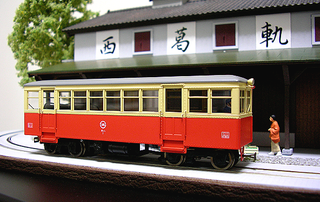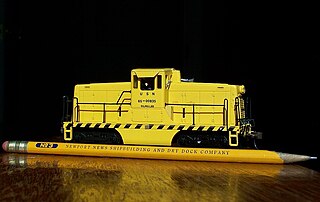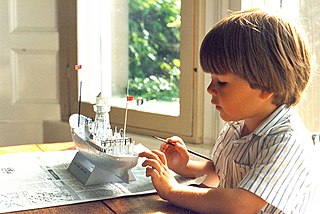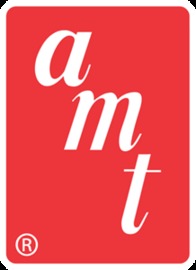
Railway modelling or model railroading is a hobby in which rail transport systems are modelled at a reduced scale.

Ship models or model ships are scale models of ships. They can range in size from 1/6000 scale wargaming miniatures to large vessels capable of holding people.

A model aircraft is a physical model of an existing or imagined aircraft, and is built typically for display, research, or amusement. Model aircraft are divided into two basic groups: flying and non-flying. Non-flying models are also termed static, display, or shelf models.

A scale model is a physical model which is geometrically similar to an object. Scale models are generally smaller than large prototypes such as vehicles, buildings, or people; but may be larger than small prototypes such as anatomical structures or subatomic particles. Models built to the same scale as the prototype are called mockups.

HO or H0 is a rail transport modelling scale using a 1:87 scale. It is the most popular scale of model railway in the world. The rails are spaced 16.5 millimetres (0.650 in) apart for modelling 1,435 mm standard gauge tracks and trains in HO.

N scale is a popular model railway scale. Depending upon the manufacturer, the scale ranges from 1:148 to 1:160. Effectively the scale is 1:159, 9 mm to 1,435 mm, which is the width of standard gauge railway. However the scale may vary to simulate wide or narrow gauge rail. In all cases, the gauge is 9 mm or 0.354 in. The term N gauge refers to the track dimensions, but in the United Kingdom in particular British N gauge refers to a 1:148 scale with 1:160 track gauge modelling. The terms N scale and N gauge are often inaccurately used interchangeably, as scale is defined as ratio or proportion of the model, and gauge only as a distance between rails. The scale 1:148 defines the rail-to-rail gauge equal to 9 mm exactly, so when calculating the rail or track use 1:160 and for engines and car wheel base use 1:148.

A toy train is a toy that represents a train. It is distinguished from a model train by an emphasis on low cost and durability, rather than scale modeling. A toy train can be as simple as a toy that can run on a track, or it might be operated by electricity, clockwork or live steam. It is typically constructed from wood, plastic or metal. Many of today's steam trains might be considered as real ones as well, providing they are not strictly scale or not enough detailed ones in favor of a robustness appropriate for children or an inexpensive production.

TT scale is a model railroading scale at 1:120 scale with a Track gauge of 12 mm between the rails. It is placed between HO scale (1:87) and N scale (1:160). Its original purpose, as the name suggests, was to make a train set small enough to assemble and operate on a tabletop.

OO9, often also denoted as 009 or 00-9 is a model railway scale and gauge combination of 4 mm scale and 9 mm gauge tracks, which models a prototype track gauge of 2 ft 3 in. It is a common choice in the United Kingdom for the modelling of narrow-gauge railways whose prototype gauges lie approximately between 2 ft and 2 ft 6 in. The 9 mm track gauge is used by N gauge model railways, a common commercial scale, which means that a selection of wheels, track, and mechanisms is readily available.

A plastic model kit,, is a consumer-grade plastic scale model manufactured as a kit, primarily assembled by hobbyists, and intended primarily for display. A plastic model kit depicts various subjects, ranging from real life military and civilian vehicles to characters and machinery from original kit lines and pop fiction, especially from eastern pop culture. A kit varies in difficulty, ranging from a "snap-together" model that assembles straight from the box, to a kit that requires special tools, paints, and plastic cements.
Z scale is one of the smallest commercially available model railway scales (1:220), with a track gauge of 6.5 mm / 0.256 in. Introduced by Märklin in 1972, Z scale trains operate on 0–10 volts DC and offer the same operating characteristics as all other two-rail, direct-current, analog model railways. Locomotives can be fitted with digital decoders for independent control. Model trains, track, structures, and human/animal figures are readily available in European, North American, and Japanese styles from a variety of manufacturers.

Kitbashing or model bashing is the practice of making a new scale model by taking pieces out of kits. These pieces may be added to a custom project or to another kit. For professional modelmakers, kitbashing is used to create concept models for detailing movie special effects. Commercial model kits are a ready source of "detailing", providing any number of identical, mass-produced components that can be used to add fine detail to an existing model. Professionals often kitbash to build prototype parts which are then recreated with lightweight materials.

Testor Corporation is an American manufacturer of tools and accessories for scale model kits. The business is based in Rockford, Illinois, and is part of RPM International. It was founded in 1929 and its products are made in the US and marketed to customers worldwide.

Military miniaturism is a niche within the broader hobby of modeling focusing on military subjects. It is itself a rather broad subject, dealing with any scale model of military theme. It has an ever growing range of sub-hobbies, including scale figure modeling, armour modeling, model ship building, military aviation modeling, and historical wargaming.
Model military vehicles range in size and complexity; from simplified small-scale models for wargaming, to large, super-detailed renditions of specific real-life vehicles.

16 mm to 1 foot or 1:19.05 is a popular scale of model railway in the UK which represents narrow gauge prototypes. The most common gauge for such railways is 32 mm, representing 2 ft gauge prototypes. This scale/gauge combination is sometimes referred to as "SM32" and is often used for model railways that run in gardens, being large enough to easily accommodate live steam models. The next most common gauge is 45 mm, which represents the theoretical non-existent gauge 2 feet 9+3⁄4 inches (857 mm). This gauge is commonly used to portray prototypes between 2 ft 6 in and 3 ft gauge.

Aluminum Model Toys (AMT) is an American brand of scale model vehicles. The former manufacturing company was founded in Troy, Michigan, in 1948 by West Gallogly Sr. AMT became known for producing 1:25 scale plastic automobile dealer promotional model cars and friction motor models, and pioneered the annual 3-in-1 model kit buildable in stock, custom, or hot-rod versions. The company made a two-way deal in 1966 with Desilu Productions to produce a line of Star Trek models and to produce a 3/4 scale exterior and interior filming set of the Galileo shuttlecraft. It was also known for producing model trucks and movie and TV vehicles.

Paper models, also called card models or papercraft, are models constructed mainly from sheets of heavy paper, paperboard, card stock, or foam.

On2 gauge is part of the hobby of rail transport modeling. The name is based on the common USA model railroad O scale of 1:48 and refers to the gauge between the rails and the fact that it is narrow gauge, thus 'On2'.
Gundam Plastic models, Gundam Plamo, or Gunpla are model kits depicting the mecha machinery and characters of the fictional Gundam multiverse by Bandai.




















